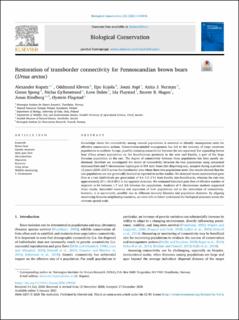Restoration of transborder connectivity for Fennoscandian brown bears (Ursus arctos)
Kopatz, Alexander; Kleven, Oddmund; Kojola, Ilpo; Aspi, Jouni; Norman, Anita J.; Spong, Göran; Gyllenstrand, Niclas; Dalén, Love; Fløystad, Ida; Hagen, Snorre; Kindberg, Jonas; Flagstad, Øystein
Peer reviewed, Journal article
Published version

Åpne
Permanent lenke
https://hdl.handle.net/11250/2722296Utgivelsesdato
2021Metadata
Vis full innførselSamlinger
- Publikasjoner fra CRIStin - NINA [2364]
- Scientific publications [1392]
Originalversjon
10.1016/j.biocon.2020.108936Sammendrag
Knowledge about the connectivity among natural populations is essential to identify management units for effective conservation actions. Conservation-minded management has led to the recovery of large carnivore populations in northern Europe, possibly restoring connectivity between the two separated, but expanding brown bear (Ursus arctos) populations on the Scandinavian peninsula to the west and Karelia, a part of the large Eurasian population, to the east. The degree of connectivity between these populations has been poorly understood, therefore we investigated the extent of connectivity between the two populations using autosomal microsatellites and Y chromosome haplotypes in 924 male bears (the dispersing sex), sampled during a period of 12 years (2005–2017) across the transborder area where these two populations meet. Our results showed that the two populations are not genetically isolated as reported in earlier studies. We detected recent asymmetrical gene flow at a rate (individuals per generation) of 4.6–5.5 (1%) from Karelia into Scandinavia, whereas the rate was approximately 27.1–34.5 (8%) in the opposite direction. We estimated historical gene flow of effective number of migrants to be between 1.7 and 2.5 between the populations. Analyses of Y chromosome markers supported these results. Successful recovery and expansion of both populations led to the restoration of connectivity, however, it is asymmetric, possibly due to different recovery histories and population densities. By aligning monitoring between neighboring countries, we were able to better understand the biological processes across the relevant spatial scale. Brown bear Genetic structure Male gene flow Microsatellites Migration Recovery Ursus arctos Wildlife monitoring Y chromosome
